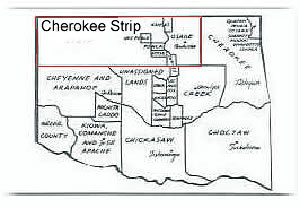|
Moderated by NW Okie! |
Volume 13 , Issue 352011Weekly eZine: (374 subscribers)Subscribe | Unsubscribe Using Desktop... |
Cherokee Strip Outlet

The Cherokee Outlet (a.k.a. Cherokee Strip) was formed by the United States government to give the Cherokee Indians of Eastern Oklahoma a path or "Outlet" to hunting lands in the West. It ran along the northern part of Oklahoma Territory.
The Trail Drovers from Texas crossed the Outlet to move thousands of head of cattle to the railroads in Kansas for shipment back east. Many drovers of these cattle drives refused to pay the Indians for passage across their land, though. The Indians frequently would stampede the cattle and in confusion liberate a few head for themselves. This is about the time a group of cattlemen (a.k.a. "The Cherokee Strip Livestock Association") finally leased the Outlet for a period of years.
Of course... this was NOT the end of the troubles the Indians and the Association ran into. It just brought more settlers slipping into the "Strip" to establish farms.
After several years... the U.S. Government stepped in because of the pressure from the people wanting the Outlet opened for settlement. This is when the lease between the Association and the Cherokee Indians was declared null and void. The government pressured the Indians into accepting a $1.25 per acre buyout for their land. In the final negotiations, the dollar sum was fixed at 8-1/2 million or approximately $1.29 per acre.
The Outlet was divided into 4 districts
- The westernmost segment was called "Woodward Land District" (formerly referred to as "N" county).
- The next division to the east became the "Alva Land District" (earlier known as "M" county. In 1907, it split into three counties... Woods, Major and Alfalfa.)
- Further to the east was the "Enid Land District" (previously "L" county and "O" county).
- At the far eastern end of the Outlet was the "Perry Land District" (which had been "K", "P", and "Q" counties).
To stake a claim... the claimants had to be of legal age (21) and not have previously claimed land in another area under the Homestead Act of 1862.
The land was not intended to be "free". The government wanted to recover the 8-1/2 million dollars paid to the Cherokee Indians for the purchase of the Strip. Congress voided the "have to repay" requirement in 1900, so most homesteaders did not pay for their land.
The claimants in the Alva Land District were required to travel to the town of Alva to file the necessary papers for their new claims. This was a time when there were no railroads, bridges or even roads in this area. The trip to Alva must have seemed like another hardship.
With filing requirements met, the claimant then had to "prove up" this land. This meant building a permanent living structure and getting the land ready for crops... IF the land was suitable for farming. Also... a claimant could not be absent from his property for a period to exceed 6 months. Upon meeting all the requirements for claiming land, the government issued a document called a "Patent," which gave the landowner title to his property.
It is reported... these people who started their new lives in the Cherokee Strip that Fall day in September 1893, were sturdy souls. Just surviving the first few years required lots of determination and muscle power. It is from this ancestrial stock which many of us living in the Strip today came. Let us remember our ancestors pasts with respect and admiration. Where would we be today if they had NOT staked their claims and stuck it out that Fall and Winter of 1893? | View or Add Comments (0 Comments) | Receive updates ( subscribers) | Unsubscribe
| © . Linda Mcgill Wagner - began © 1999 Contact Me | |
